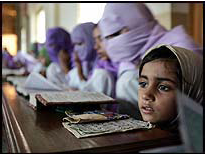A ‘madrasa’ is an Islamic religious school. Farhana Ali describes her experience of visiting madrasas in Pakistan. Fundamentalist religious schools, such as Islamic Madrasas, mostly employ mimetic pedagogy.

An encounter with these girls is like revisiting a period in ancient history. Some girls from distant villages never leave the seminary, except for the two Islamic holidays, Eid al-Adha and Eid al-Fitr. They also receive room and board, in addition to an education in Islam, which includes memorization of the Qur’an for younger girls, and lessons in history and the Arabic language for older students. Not every girl lives in the compound, nor is from a poor family—a Western misperception. Many students come in vans provided by the madrasa and some belong to affluent families, including the daughters of Quetta’s high-ranking officials and army officers … Most of the money that supports madrasa activities comes from the ‘public’. The public could include several sources, from the richest families of Pakistan to local organizations. As one Deobandi madrasa leader explained to me, ‘we offer free education to the public, and receive monthly gifts from the parents. We accept whatever the public wants to give.’ The public gives freely to the madrasas in the form of charity, which means that madrasas seldom have to write it down …
What these students do with their religious education is a personal or family decision. Girls in Quetta and Rawalpindi, a congested town outside of Islamabad, reveal that after graduation they intend to open madrasas in their villages to teach others what they have learned. Whether the more conservative men will allow the female graduates to continue their education is a separate issue, but most girls (and boys) seek to establish their own Islamic networks and schools. Others have high hopes. For example, boys in the Dar ul-Uloom Naeemia seminary, one of Karachi’s largest, aspire to be Islamic scholars (‘alim), while others understand the need for secular education …
When asked about the madrasas’ links to al-Qaeda—a common Western fallacy and accepted truth—every imam or hafiz (one who has completely memorized the Qur’an) boldly told me, ‘there is no link, and if there is, where is the proof?’ A teacher at Karachi’s Dar ul-Uloom Amjaddia madrasa, a boys school with nearly 1,000 students, insists that ‘international propaganda wrongly accuse Pakistan’s madrasas of supporting terrorist networks, and we have no resources to defend ourselves’ …That is not to say that jihad is absent from the curriculum. ‘It is in our religion,’ said one madrasa leader, ‘but it is defensive jihad—the same jihad that we fought against the Soviets [in Afghanistan in the 1980s] with the support of the Americans’… [It] is not difficult to understand why many seminaries respect bin Laden, though reject his call for arbitrary violence. Al-Qaeda expert and talk-show host in Islamabad, Hamid Mir, says that ‘bin Laden is the hero by default,’ or according to a madrasa manager from an Ahl al-Sunna School, ‘he is the lesser of two evils’. Many madrasas in Pakistan, particularly those in the Northwest Frontier Province, blame the U.S. for failing to secure Afghanistan after the Soviet withdrawal and argue that U.S. foreign policies, such as the war in Iraq, continue to fuel the fire for jihad.
Ali, Farhana. 2006. ‘Inside Pakistan’s Madrasas.’ Terrorism Focus 3:4–5.
